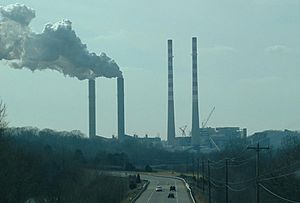Cumberland Fossil Plant facts for kids
Quick facts for kids Cumberland Fossil Plant |
|
|---|---|
 |
|
| Country | United States |
| Location | Cumberland City, Tennessee |
| Coordinates | 36°23′29″N 87°39′17″W / 36.39139°N 87.65472°W |
| Status | Operational |
| Commission date | 1973 |
| Owner(s) | Tennessee Valley Authority |
The Cumberland Fossil Plant is a very large power station. It is located near Cumberland City, Tennessee in the United States. This plant uses coal to make electricity. It sits on the Cumberland River, next to Lake Barkley. The Tennessee Valley Authority (TVA) owns and runs the plant. It can produce 2,470 megawatts (MW) of power. This makes it the most powerful power station in Tennessee.
Contents
What is the Cumberland Fossil Plant?
The Cumberland Fossil Plant started making power in 1973. It has two main parts, called units. Each unit can make 1,235 megawatts of electricity. In 2004, these two units made almost 12% of all the electricity TVA produced.
How Does the Plant Work?
This power plant burns a type of coal called bituminous coal. The coal arrives at the plant by barges on the Cumberland River. The plant uses about 20,000 tons of coal every single day. When coal burns, it heats water to create steam. This steam then spins large machines called turbines. The turbines are connected to generators, which make electricity.
Tall Chimneys at the Plant
The Cumberland Fossil Plant has two very tall chimneys. They are 1,001 feet (305 meters) high. These chimneys were built in 1970. They used to release smoke from burning coal into the air. Now, smaller chimneys are used instead. These new chimneys are connected to special equipment that cleans the air.
How Does the Plant Protect the Environment?
Power plants that burn coal can release things into the air. The Cumberland Fossil Plant uses special systems to help keep the air cleaner.
Reducing Air Pollution
To reduce harmful gases, the plant uses "scrubbers." These are like big filters that clean the smoke before it goes into the air. They help remove sulfur dioxide (SO2). Sulfur dioxide can cause acid rain.
The plant also uses other systems to reduce nitrogen oxides (NOx). These systems were put in place in 2004. They help make sure less of these gases are released.

